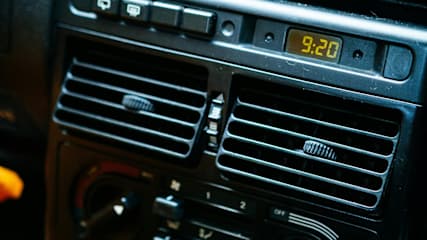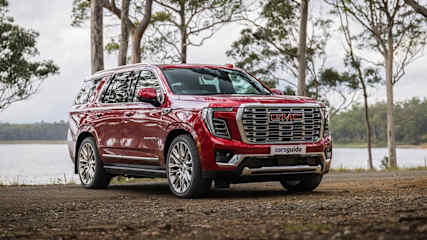Here's why monster US imports including 2025 GMC Yukon Denali, Ram 1500 and Chevrolet Silverado really aren't built for Australian conditions | Opinion
By Marcus Craft · 08 Jun 2025
The GMC Yukon Denali is the latest arrival in a continuing US vehicular invasion of Australia. Imported here as left-hand drive and then converted to a right-hander, the Denali is a big 4WD wagon with eight seats, a petrol V8 engine and a standard features list as long as LeBron James’s arm.Brought to our shores by General Motors Specialty Vehicles (GMSV), the Denali is a premium-style vehicle; massive, comfortable and, as an eight-seat 4WD wagon, it has few rivals in the Aussie market. But it lacks a competitive warranty, its price-tag puts it way out of reach of a lot of 4WD buyers, and for a few distinct reasons it is a sterling example why US wagons and utes don’t belong in Australia.It’s too big.It’s big. Even the signature Denali grille – with LED headlights and chrome accents – is the size of a tiny house. The 2025 Denali is 5337mm long (with a 3071mm wheelbase), 2378mm wide, 1943mm high, and it has a kerb weight of 2813kg.The interior is great because it is big, roomy and occupant friendly, but the Denali’s gargantuan exterior dimensions simply mean it’s a beast of burden in busy city or suburban streets, and even on bush tracks, which can be quite narrow.The Denali demands to be driven with supreme consideration – and even more patience, more skill, and more experience than smaller four-wheel drives require – in order to avoid city- or bush-related damage, incidental or otherwise.Also, worth remembering is that fact that no matter how good a driver you are, there’s always a shopping trolley, key-wielding person who hates big vehicles, or someone who only parks their car by ‘touching’ the vehicle nearest to them out there, waiting to ding/scratch/dent your US behemoth. You’ve been warned.It’s not built for Australian conditions.The Denali is imported to Australia as a left-hand drive vehicle and then Walkinshaw's subsidiary company Premoso remanufactures the US 4WD wagons to right-hand drive at their facility in Clayton, Victoria. But the problems aren’t with Premoso’s work – they’ve done an impressive job – the flaws are in the vehicle’s original design and build.For one, as mentioned, it’s big. If you aren't used to steering a tank-sized 4WD around town then driving the Denali is going to be a very steep – and possibly very expensive – learning curve.Two, it’s built for open-road cruising on US freeways; it’s not engineered to cope with our punishing dirt-road corrugations of Australia, or our extreme heat, or our poorly maintained backroads and bush tracks.Thirdly, the Denali lacks the prestige fit and finish and build quality usually showcased in something at this price-point. Instead, there is hard plastic throughout, storage receptacles with flimsy lids, and lacklustre fit and finish.Also, this Denali is on 24-inch rims and paper-thin Bridgestone all-season tyres (285/40R24), which is not a wheel-and-tyre package suited to anything other than driving on the blacktop. These tyres don’t offer the grip of a decent all-terrain tyre and you can’t drop air pressures because there isn’t enough tyre there.The Denali has a naturally-aspirated 6.2-litre V8 petrol engine – producing 313kW and 624Nm – and that’s matched to a 10-speed automatic transmission.This is a great vehicle to drive on-road for general day-to-day driving duties – settled and composed – and it’s close to flawless on the open road, smooth and refined, but that big V8 – as great as it sounds – has the potential to drink … a lot.The Denali’s air suspension – which aims to level out even major imperfections in the road or track surface – and its special dampers aren’t as effective or as seamless a system as the Patrol/Patrol Warrior’s Hydraulic Body Motion Control, which acts as a sway bar and sway bar disconnect equivalent and is very impressive. Official fuel consumption is listed as 12.8L/100km (on a combined cycle), but on my most recent test of it, I recorded 16.2L/100km. Not too bad, all things considered, but you have to remember that I didn’t have much weight onboard and I wasn’t towing anything.The Denali has a 91L fuel tank so, going by my on-test fuel-consumption figure, you could reasonably expect a driving range of about 560km from a full tank. Once loaded up with real-world burdens (e.g kids, dogs, camping gear etc) then you’ll soon see the Denali’s fuel use climb.It’s expensive.The Denali has a price tag of $174,990 (excluding on-road costs), making it a lot more expensive than most vehicles that could be considered rivals in the Aussie market.Until now, if you’d been looking for an eight-seat 4WD wagon with a petrol V8 engine, you'd be limited to considering something like a Nissan Patrol or a Land Rover Defender 130, but at least the Patrol is almost half the price of a Denali.Another thing, as mentioned earlier, the Denali does not have the high quality of fit and finish and build quality usually associated with vehicles that cost this much – that’s disappointing.And maximum braked towing capacity in the Denali is listed as 3628kg (when it has a 70mm ball and weight-distribution hitch) – which isn’t that much more than other large 4WD wagons or utes in Australia offer (3500kg maximum braked towing capacity).US utes and wagons are big, bloated, overpriced and underdone – and they should go back from whence they came.Cue the hate mail...


.jpg)
_0.jpg)


.jpg)

.jpg)

